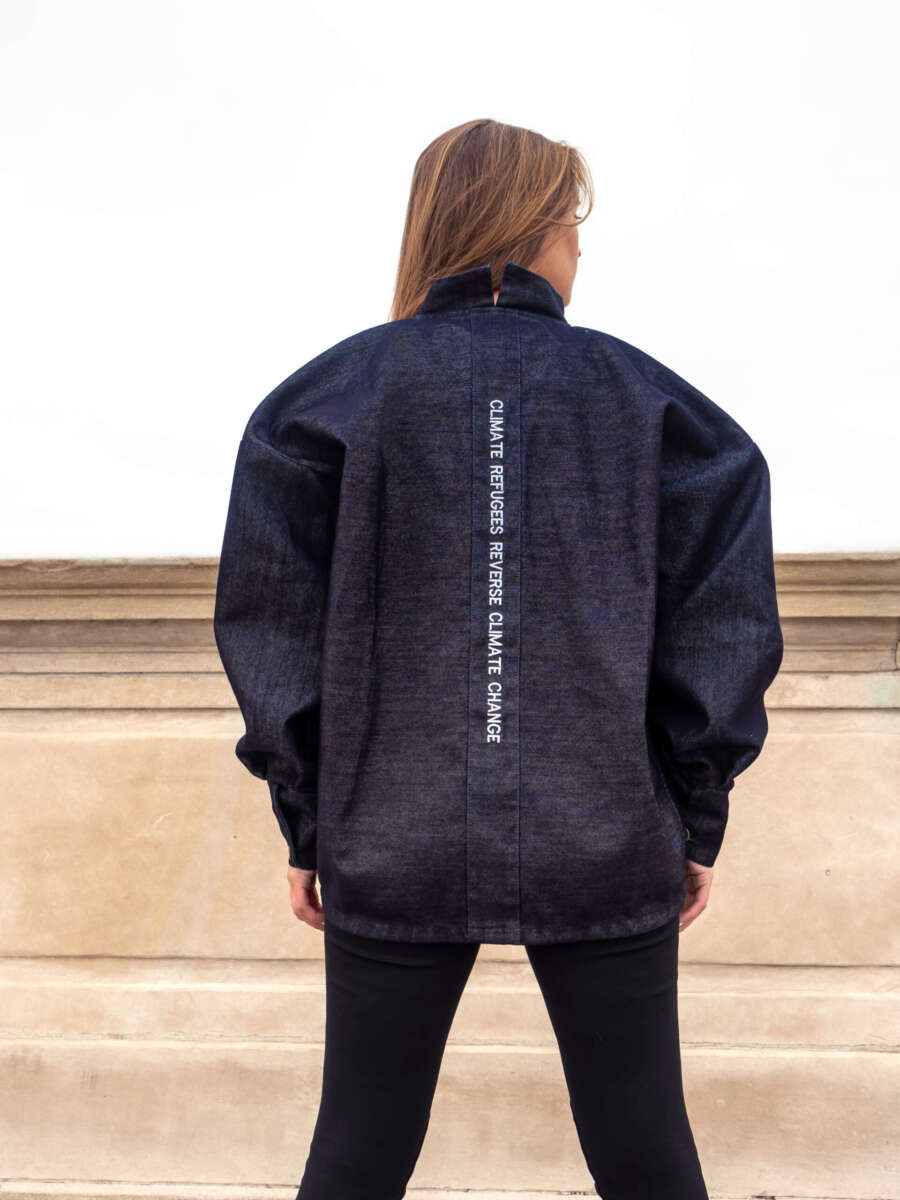Can Fashion Help Climate Refugees?

Share This Article
“The places that climate change impacts the most are where people are already vulnerable.” It’s an eye-opening statement from SXD designer Shelly Xu. In cities like Boston (where she is based as she finishes her studies at Harvard Business School) and Philadelphia (where I am), the impact is less noticeable. Yet, in Bangladesh, it’s estimated that by 2050 one in every seven people will become climate refugees. For reference, in the US it’s estimated that only 1 in 2 people will “see a decline in the quality of their environment”. It’s facts like these that led Shelly to try to find a way to empower climate refugees by training and employing them as the artisans crafting SXD’s zero-waste kimono-inspired jackets.
Bangladesh is exceptionally vulnerable to climate change. Its low elevation, high population density, and inadequate infrastructure all put the nation in harm’s way, along with an economy that is heavily reliant on farming.
~ Environmental Justice Foundation
In Bangladesh, where her zero-waste jackets and other pieces are made, the garment industry supplies jobs to 4.4 million people with 4 out of every 5 being women who are already a marginalized group within the fashion industry. While studying at Harvard she met Ahmed Fardin, a Bangladeshi native who wrote his thesis on climate refugees. “He’s seen the impact of rising sea levels,” Shelly says. The two met and the budding designer decided that a sustainable fashion label could be “a really good initiative to help refugees”.
Shelly chatted about her zero-waste designs, the roadblocks small sustainable brands face, and the learning curve to creating a brand that is truly making a difference in other people’s lives.

It Begins With A Better Wage
Drawing inspiration from an efficient design like a kimono (which uses a single piece of cloth cut into 7 pieces), Shelly and her team have been able to pass on savings from having less waste from fewer pieces to provide garment workers a higher wage. To be exact, Shelly and her team pay 4x the local minimum wage and 2x the Fair Trade minimum wage for Bangladesh. Finding the balance between livable and market-appropriate wages was a learning experience for Shelly as a business founder. “If you pay them too much it can create adverse behaviors in the market,” she explains. “It becomes closer to a skilled worker with a college degree. We don’t want to discourage women from learning and studying to become engineers or create unhealthy competition from people who are not refugees.”
They are not victims, or liabilities. But, they’re really talented and create beautiful clothing that are world class in quality.
Shelly Xu
The other benefit of working with a minimalist design was that Shelly and her team were able to give work opportunities to more climate refugees. “By having simple, efficient designs, anyone can make the pieces even if they’re newly trained. Our design wasn’t a limiting factor about who we could hire,” she further explains. She usually works with refugees that have been trained by a larger organization that matches them with jobs within the garment industry.

Designing For Zero Waste
In Shelly’s words, the traditional Asian kimono is about “maximizing beauty without wasting fabric and using minimal cuts and design”. This, paired with her zero-waste mentality makes SXD a brand focused on minimizing its environmental impact. One of the things Shelly wanted to change within the fashion industry was the noise around sustainable fashion and greenwashing. She wanted to start with as much “purity as possible and focus on zero waste materials”.
Your Buzzword Breakdown: What Makes Environmentally Friendly Clothes Eco?
To her, it’s a better solution than relying solely on natural fabrics, which still have an environmental impact. “That’s a gray area. How much water is going into that cotton? How much water pollution?” She asks. “But, if you take something that is zero waste that is much more waste and concrete.” That’s something that she’s learned and pushed hard for. So, instead of using organic cotton materials, Shelly focuses on using organic cotton that is a cast-off or would otherwise be disposed of by another fashion brand.
At SXD, we are telling the story of people who have been affected the most by climate change and being empowered to fight the Behemoth that uprooted their lives. All through sustainable fashion.
Ahmed Fardin
Shelly and her team calculated the average denim waste from factories in Bangladesh. “When you create similar designs you have similar waste from those designs,” she says. So, they were able to figure out the average dimensions of the waste materials so that they were able to use those cutoffs to make SXD jackets.

Becoming More Sustainable With Time
There are benefits to being a big brand in terms of what you can do as far as sustainable initiatives go. Take for instance shipping. In the future, SXD will focus more on maritime shipping because it’s better for the environment. Yet, for now, each piece is put onto planes. To help reduce carbon emissions, they’re shipped in small batches on planes that are already en route to the destination country.
These Brands Measure Your Impact To Show You How To Be More Eco Friendly
Recently, SXD just sold out of their first batch of jackets and they’re working on their second batch. “So, we asked customers which do you prefer- raw denim (which you can’t wash at first because it bleeds) or denim that has been chemically treated to preserve the colors,” she says. If it’s annoying to wash, Shelly notes that people may not want to wear a piece of clothing. And, that defeats the purpose of creating a zero-waste item that is meant to be worn not disposed of. But, there’s also the question of how can you make the most sustainable garment as well. “We wanted to hear from each other and have a conversation,” she says about finding the best sustainable solution.
